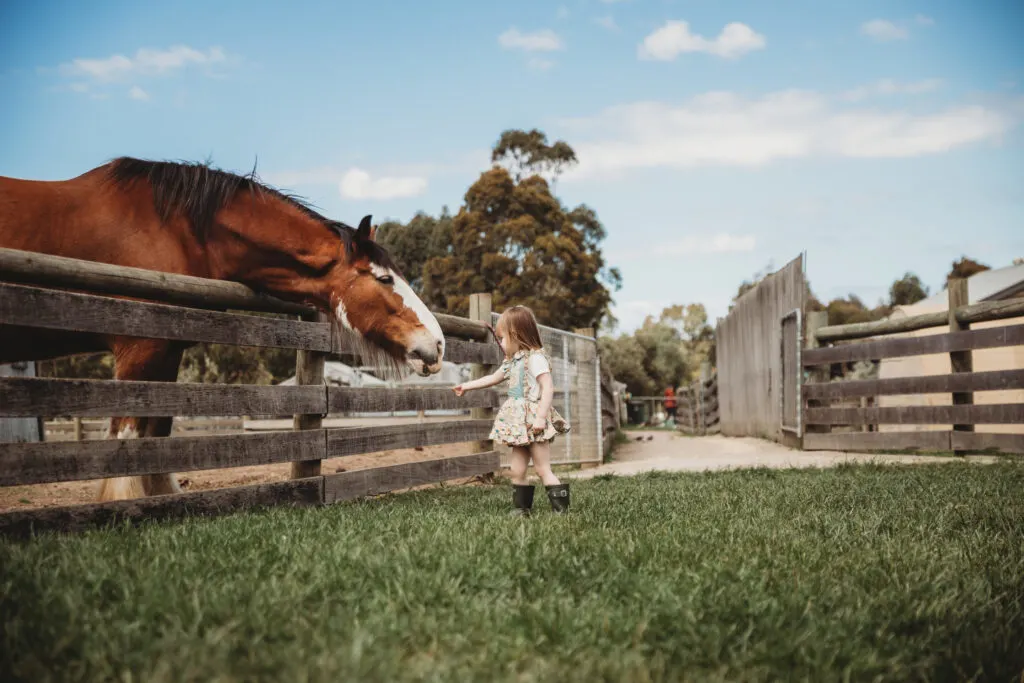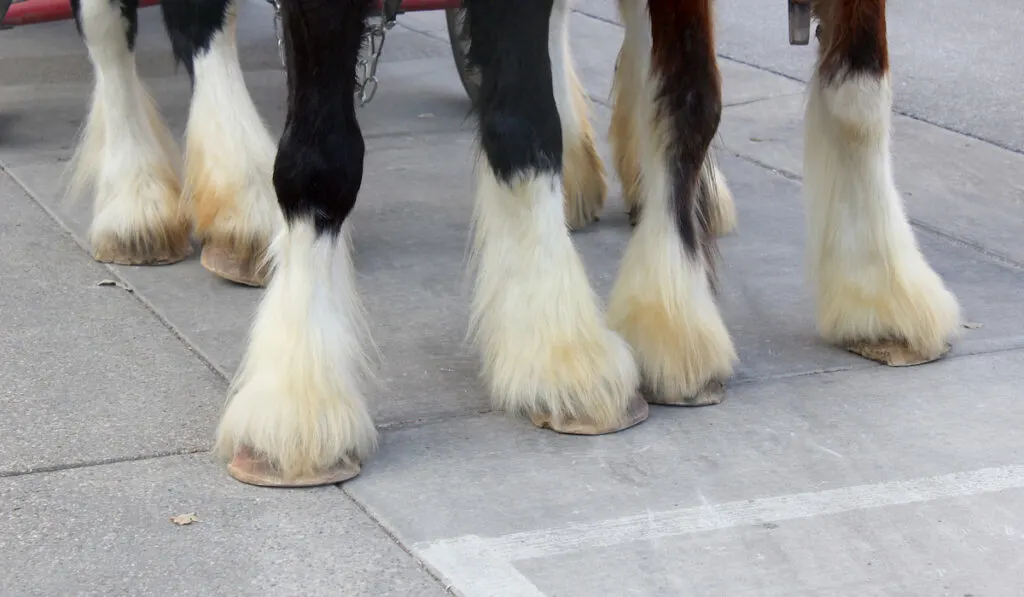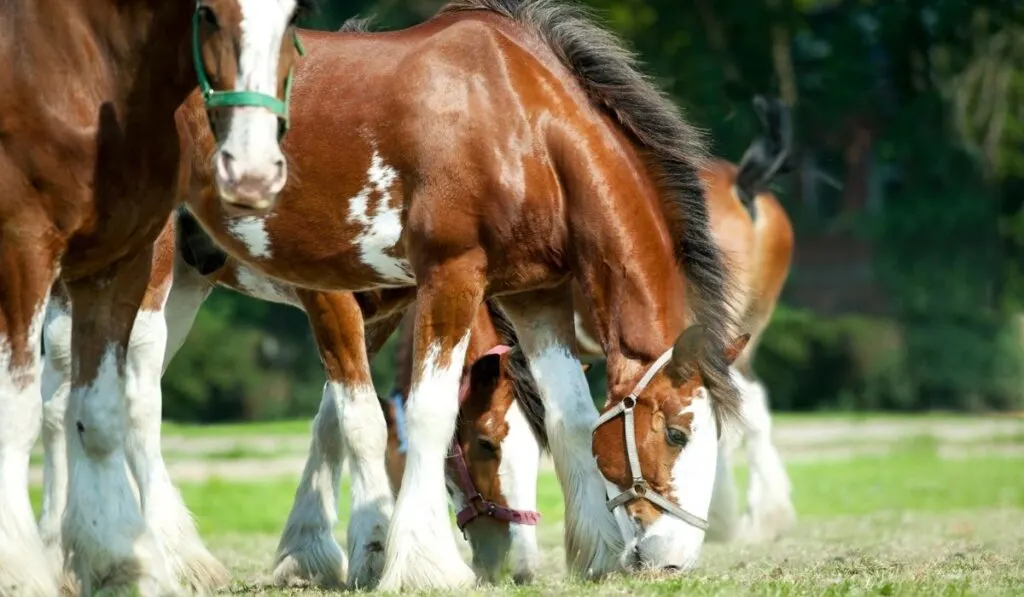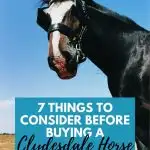A Clydesdale costs from $600 to $18,000. The average Clydesdale cost is ~$7,000. Younger Clydesdales cost anywhere from $1,200 to $7,000. Older horses with potential, and especially black Clydesdales, are for sale from $15,000 to $18,000. These numbers are based on an analysis of live Clydesdale sales listings on equinenow.com/clydesdale.
Clydesdale is a pure breed, and Registered Animals with papers typically sell for more than purebreds without papers. Clydesdales can be crossed with other breeds too, which can lead to them costing more or less depending on the breed cross. Features like coloring also drive unique pricing. Purebred and crossed Clydesdales can be found at all price ranges, as we’ll see below.
All that said, the ownership cost of a Clydesdale is extreme. Read the sections below for more pricing data and tips on Clydesdale ownership and 7 key features of Clydesdales we think you should consider before purchasing, so you understand the benefits of big horses moving forward.
Table of Contents
Key Clydesdale Ownership Details:
- An analysis of Clydesdale horse listings on EquineNow.com shows an average Clydesdale sale price of ~$6,000, with a wide range of $600 to $18,000.
- Younger, smaller Clydesdales go for less, while older, larger, and especially black and blue roan variants go for more. Registered purebreds, rare cross-breeds, and unique coloring will tend to drive the price up.
- Younger, smaller Clydesdales go for less, while older, larger, and especially black and blue roan variants go for more. Registered purebreds, rare cross-breeds, and unique coloring will tend to drive the price up.
- Clydesdale ownership costs can easily reach $10k/year, since they require more expensive boarding, more food, and (in some cases) specialized vet services and staff safety training.
- Check sites like equinenow.com/clydesdale to find clydesdales available for purchase.

How Much Does a Clydesdale Horse Cost (Average for Purebreds and Crosses)
The cost of buying a Clydesdale Horse can range from $600 to $20,000+ depending on the age, breed, and history. Using an online Clydesdale marketplace like equinenow.com/clydesdale you can find options that fit your budget and find out what Clydesdales are available. Remember: only 600 new Clydesdale foals are registered each year in the US.
Many great Clydesdale horses on the younger and browner side often sell between $2500 and $5000. Thoroughbred horses go for more. Note that, as mentioned in the intro, features like the crossbred or special coloring will drive some of this pricing for each animal, not just its age and training. Purebreds and crosses can be found at all price ranges.
To give you a sense of the “real” purchase price of a Clydesdale, we analyzed a sample set of 30 listings on this site in late 2023 to give some real numbers for you. These were live listings in November of 2023, and the six below show what two lower cost, two average cost, and two higher cost options are, as well as the key features that influence those price points:
| Horse Description | Location | Price | Key Features |
|---|---|---|---|
| Lower Price Range | |||
| Rose – Red Roan Flashy Clydesdale Mare | Middletown Ohio, OH | $1,200 | – 14 year old, 16.1H red roan mare. Broke to ride. Recently weaned a foal. – Note, extremely low price, examples of a “great deal” |
| Vaulting Horse – Beginner Safe | Texas | $3,000 | – Clyde/TB sporthorse. Suitable for vaulting. Beautiful, sweet temperament. |
| Middle Price Range | |||
| Gorgeous Hanoverian / Clydesdale Filly | Virginia | $6,000 | – Black Hanoverian/Clydesdale cross. Competing siblings in training level Eventing and foxhunting. |
| Registered Beautiful Black Clydesdale | – | $5,000 | – 6 year old. Great on trail rides. Smooth walk, trot, and canter. |
| Upper Price Range | |||
| Reba-Bay Clydesdale Mare | Taneyville, MO | $15,500 | – Lots of experience with the public and children, a beautiful light bridle coloring. |
| Spring Water Charisma – Once in a Lifetime Mare | Camas Valley, OR | $18,000 | – Born and bred on farm. Clydesdale/Warmblood. One of the owner’s personal favorite riding horses. Stunning black and white coat. |
What Does It Cost To Own A Clydesdale (Ownership Cost)
Clydesdales are an expensive breed to own due to their impressive size and involved care, so it’s important to factor in the full costs of owning a Clydesdale before you move forward. Costs include:
- Basic Care
- Feed: $100+ per month on hay easily
- Shelter: Requires custom, spacious housing, listings on equinenow.com show $600-$1000/mo to board a Clydesdale. (equinenow.com/clydesdale)
- Hoof/dental care, vaccines: $2,500 – $5,000 yearly
- Training & Shows: $5,000 – $10,000+ annually
- Breeding: Stud fees, mare/foal care, registration fees
- Safety Precautions: Special trailering, handlers, equipment due to size
- Total Yearly Cost: Often $10,000+
In summary, Clydesdales’ striking appearance comes at a steep price. However, devoted owners agree the rewards outweigh the substantial costs. See this Annual Horse Expense Sheet for a better idea of how to plan the costs of owning your Clydesdale horse.
Clydesdale Breed Stats
If you’re serious about owning a Clydesdale, there are more details you should know below, starting with their overall breed stats. Here are the features of a Clydesdale that make them different, starting with their extreme size:
- Height of Clydesdale Horse: Ranges from 167 to 183 cm (approximately 66 to 72 inches). On average, males stand at about 172 cm.
- Weight of Clydesdale Horse: Typically falls between 700 and 1000 kg. Males average around 850 kg, while females average about 750 kg. In terms of pounds, they weigh between 1,600 and 2,400 pounds.
- Origin of Clydesdale Horse: Scotland.
- Primary Use of Clydesdale Horse: Draught and show.
- Common Colors of Clydesdale Horse: Bay or brown with white markings.
- Distinctive Features of Clydesdale Horse: Noted for their silky, feathered legs and stylish movement.
- Lifespan of Clydesdale Horse: Generally between 25 and 30 years.
- The character of Clydesdale Horse: Known for their gentle nature, noble features, and a willing attitude.
- Gait of Clydesdale Horse: Characterized by stylish gaits that are powerful and cadenced.
- Suitability of Clydesdale Horse for Riders: Appropriate for all levels of riders.
These characteristics highlight the unique attributes of the Clydesdale breed, showcasing their stature, temperament, and versatility (source).
As far as their origin and history, The Clydesdale is a distinguished Scottish breed of draught horse, originating from the Clydesdale valley near the River Clyde in Lanarkshire. Their numbers dwindled in the early 20th century due to the First World War and agricultural mechanization.
Clydesdales are now mainly carriage horses, seen in parades and processions, and notably employed by the Household Cavalry and the Anheuser-Busch brewery (Budweiser horses) in the US.
How Much Bigger Is a Clydesdale Than a Regular Horse?
Clydesdale horses are significantly larger than average horses. They typically stand between 64 to 72 inches (162.56 to 182.88 cm) tall, which is 4 to 16 inches (10.16 to 40.64 cm) taller than the average Quarter horse, standing at 60 to 68 inches (152.4 to 172.72 cm).
Clydesdales also weigh considerably more, with an average weight of about 2,000 pounds (907.18 kg), compared to regular horses, which usually weigh between 900 to 1,200 pounds (408.23 to 544.31 kg). This significant size difference highlights Clydesdale’s status as one of the largest horse breeds.
1. They Are Really Big
You probably know that they are big right, so this may seem too obvious. The fact of the matter is that bigger is not necessarily better.
Due to their size, you need to consider that a lot of the stuff you use for a regular-sized horse will need to be much bigger to accommodate the size of a Clydesdale. This includes your trailer, your tack, your corrals, and your feed bill.
That doesn’t mean buying a Clydesdale horse isn’t a good choice. As long as you consider any extra expense due to their size, they do make great horses to own.
2. Bay Isn’t The Only Color Available
Budweiser has made the Bay Clydesdale color very popular. It is the only color they will use to pull their carriages. But, did you know that Clydesdale horses come in other colors as well?
Clydesdale horses can be black, bay, gray, roan, and even chestnut. They almost always have white on their faces and legs.
3. Grooming Takes A While
Grooming a Clydesdale horse will take longer than grooming a non-feathered horse. You see, not only is there more horse to groom, but there are special steps you need to take to keep those beautiful leg feathers looking their best.
That typically means that special whitening shampoo must be applied and allowed to sit. Once the feathers have been shampooed and are clean, they are typically dried one by one with a blow dryer.
Failure to dry the leg hair completely can lead to conditions like scratches, which causes irritation, swelling and can even cause the hair to fall out. The process of hand drying four legs can be quite time-consuming.

4. They Can Learn Their Strength
This is true of any horse but especially so with draft horses. Care must be taken while training to ensure they learn each task without resistance. Clydesdale horses can be just as light as any horse but, they can also learn that you aren’t strong enough to hold them.
This can lead to bad habits in a variety of different places. The horse might learn that you can’t hold their foot up so they shimmy around and take it from you. Some draft horses get so bad in this regard that they need to be shod in stocks.
I once worked with a draft that learned that he could leave whenever he wanted. He would lead just fine most of the time but, if the feed cart was coming around for dinner, he’d just head right back to his stall knowing you couldn’t stop him. With good training, most horses shouldn’t learn these bad habits, but you do need to take extra caution to prevent it with a larger horse.

5. They Eat Twice As Much As A Normal Horse
How much does a Clydesdale eat?
A normal horse is anywhere from 800 – 1000 pounds on average. The general guideline for feeding an 800 – 1000 lb horse is to feed 8 – 20 lbs of hay.
You see, horses who are currently in good weight need to consume 1 – 2% of their body weight in hay each day to maintain that weight. (source) For a 1,000-pound horse, that means they need 10 – 20 lbs of hay each day.
A Clydesdale horse can weigh between 1,500 and 2,200 lbs on average as an adult. (source) That is almost twice the size of a normal horse. That means they will require twice as much food. A 2,000 lb Clydesdale horse will require between 20 and 40 lbs of hay a day to maintain weight.
And this is a maintenance diet, the more the horse works or is used, the more hay it will require to stay in good health.
6. Shoeing Costs More
A normal horse wears normal-size shoes. The Clydesdale horse has a large hoof to match its large body. This means that these horses need a much larger shoe than normal horses. Typically the larger or more specialized the shoe, the more expensive they are to put on.
In addition, if your horse does not stand well for the farrier and requires stocks or specialized sedation to help with shoeing, the cost can go up by a lot. Keep in mind that all horses should have their feet tended to at least every 6 – 8 weeks.

7. They Are a Great Choice for a Larger Rider
Let’s face it, the American population isn’t getting skinnier. Heavier riders need heavier horses. As a heavier rider myself, I know what it is like to feel “too small” on a horse. That’s part of the reason I wrote the article on choosing the right-sized horse for your height and weight.
The great thing about the Clydesdale horse is that it is big enough to accommodate any size rider. A 380 lb man would be no problem for a mature Clydesdale. The great thing is, that smaller riders are no problem either.
Frequently Asked Questions:
How Rare Are Clydesdales?
Clydesdale horses are currently considered a rare breed. Their numbers have drastically declined following the First World War and the mechanization of agriculture. They are listed as “vulnerable” by the Rare Breeds Survival Trust. In the United States, approximately 600 new foals are registered each year. These efforts reflect the ongoing dedication to preserving this magnificent breed.
What Horse Breed Is Bigger Than a Clydesdale?
The Shire horse is typically considered to be larger than the Clydesdale. While Clydesdales are impressive in size, the Shire horse has historically been recognized as the largest horse breed. Another breed that is often larger than Clydesdales in terms of weight is the Belgian horse. Though Clydesdales may be of similar height, Belgian horses usually weigh more.
How Are Clydesdale’s Registered?
There are two main registries for this breed: Clydesdale USA and Clydesdale Horse Society. You can see their sites for their individual requirements for registering, and how to transfer a Clydesdale horse registration.
Sources:
- https://www.clydesusa.com/resources/register-clydesdale
- https://www.clydesusa.com/faq/#:~:text=feed%20each%20day.-,How%20many%20Clydesdales%20are%20born%20each%20year%3F,-The%20United%20States
- https://www.equinenow.com/horse-ad-1516773
- https://www.equinenow.com/horse-ad-1497560
- https://www.equinenow.com/horse-ad-1516579
- https://www.equinenow.com/horse-ad-1512046
- https://www.equinenow.com/horse-ad-1503567
- https://www.equinenow.com/horse-ad-1512339
- https://www.clydesusa.com/resources/register-clydesdale/
Related Reading:
If you have time, check out these other interesting articles we’ve written:
- Best Reins for Trail Riding
- Why Grass Isn’t As Great As You Think
- Measuring Horse Height in Hands (with Chart)
- Check out some Clydesdale breeders of the USA if you’re ready to make a deal!


